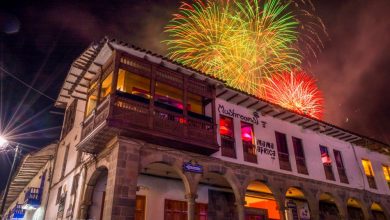A Day in Deep Gorge and Versalles: Seeing a Coffee Cooperative and Extension Services

It is easy to think of small farmers in the many scattered and remote valleys of Peru, with its highly broken terrain and very thin road system, as being traditional. One sees them wearing indigenous dress and living in self sustaining communities where there lives are spent in an annual round of agricultural work and ritual.
This romantic notion is widespread and false.
I recently spent a couple of days in the Yanatile Valley, one of the remote areas of Cuzco at the invitation of local son and barista Neto Solórzano Vizarreta.
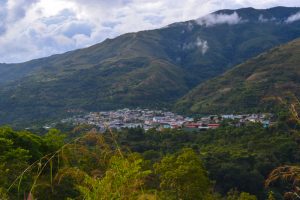
The road there, with its many fords over streams, some large and rushing and some just trickles, and its steep cliffs at the side of a narrow ribbon of road that barely accommodated one lane of traffic, not the two that actually use it, is grueling to drive. It requires constant attention and luck.
Nevertheless, on arrival to the district’s capital, Quebrada Honda or Deep Gorge, I was greeted by an agricultural fair in the new sports complex. Rural cultivators had brought examples of their products to be shown and judged. There was a wide range of products, from yuca tubers, to avocados, citrus fruit, hot peppers, corn, unhkucha, and coffee.

The biggest draw of the fair while I was there, however, was a guinea pig race. It is held every year and champions are celebrated.
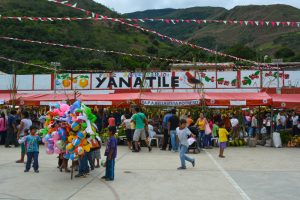
One large corner of the fair carried a banner announcing a project to improve the value and recognition of the district’s coffee production. Founded less than a year ago, through the action of local government in conjunction with Prom Peru and the national Ministry of Agriculture, the project forms a cooperative and proposes to create a Yanatile brand of quality that will be widely recognized and, hence, able to command a high price.
As the district’s mayor explained to me, this is a major element of his term of office and he hopes it will continue into future governments.
He said that Yanatile’s coffee is recognized by merchants, though not by wide publics in Peru or abroad. He says merchants come to town and buy coffee beans and then send them to other major coffee regions to be combined with other beans to make blends. Yanatiles’s coffee beans currently go to Cuzco, Puno and Central Peru.
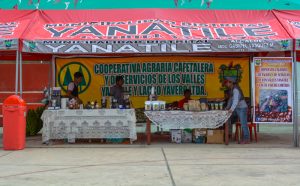
He wants yanatile to be its own name and marketable brand. Though new the cooperative already has enrolled 200 farmers in the Yanatile Valley and the Yavero Valley. It is working with engineers and technicians to improve both cultivation and post harvest processing of the beans to guarantee a brand of the highest quality with excellent and distinctive flavor profiles.
After leaving Quebrada Honda, we crossed the Yanatile river and drove up a dirt track to the small town with the romantic name of Versalles where, yes, there was someone who could converse in fluent French about the Sun King and contemporary France.
Though named after the Palace of Versailles, this small town made of wood and adobe buildings huddled along the dirt road and dwarfed by steep rock rising thousands of feet, is in the province of La Convención and belongs to the district of Ocobamba.
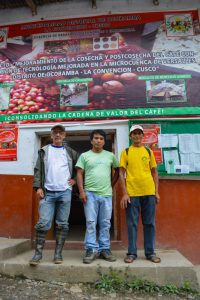
Right across from the small, unmarked eatery where we stopped to sip coffee and meet people, a banner covers the front of a building. It announces a similar project organized by the Municipality of Ocobamba, also with technicians and engineers from outside.
They are working to improve local understandings of what a quality cup of coffee is and how they can attain it through careful control of their soils, natural fertilizers, and planting properly. They are also training people on improving the variables of post harvest, such as fermenting the coffee berries and then drying the beans properly.
As one of the technicians explained to me, while we were sitting by a small Adobe home high up on the slopes of a mountain along the Tunki Mayo, the Cock of the Rock River, in a five hectare plot of land Santo Domingo, the older farmers are loath to make changes in their production.
In the case of this farmer, Neto Solórzano´s father, the changes were driven by his sons. They saw the need and appreciated the chance to plant new varieties of plants and take on new means of cultivation and processing of beans and convinced their father, he said, to implement the changes following the instructions of the technicians.
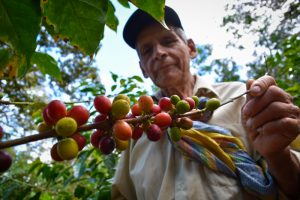
This kind of agricultural extension in Peru is not new. It has origins in the past, especially in the efforts of the military governments following the agrarian reform to improve cultivation and bring formal norms of production, with an eye on external markets.
Granted both the area of Quebrada Honda y Versalles are coloniazation zones and not traditional areas of traditional family farming. But the pattern you see here is true in most of Peru. Agricultural extension has been involved in even the most remote areas, as has market penetration, and is responsible for ongoing change in small-scale agriculture throughout the country.




